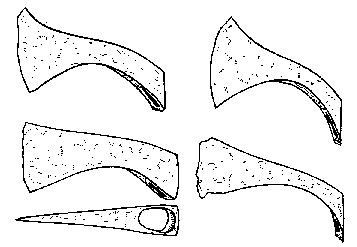Recently I found some interesting information in a book about anglo-saxon art:
There was no proper "clash of cultures" when the germanic tribes immigrated to/invaded Britain, as one might have imagined it due to the usual phrasing of the Anglo-Saxons driving the Britons to the peripheral regions of the Isles. Moreover the culture and art of the germanic tribes coming to Britain was not in total opposition to the celtic culture of its indigenous population nor to the culture of the retreating romans, nor was there a purely celtic culture among the population in southern post-roman Britain.
The Angles, Saxons and Jutes had been in contact with roman culture for centuries and had already in their homeland adopted certain elements of roman art and craftmanship into their specific styles. These were mainly designs for military equipment but also women's clothing and ornamentation of jewelry. For example the common motif of a bearded head supported by seabeasts is an adaption of the roman protective motif of Oceanus, accompanied by marine beasts, that was often found on the shields of roman soldiers. Furthermore high-status burials of germanic chieftains often display roman status symbols, not as spoils of war, but in a such a way that the dead person was put on one level with high roman military officials, which were the highest roman authority known to the germanic peoples in the regions adjacent to the limes.
The romanisation of the populace of modern England and Wales was even more intense and a certain romano-celtic style had developed, especially among the higher strata of society, influencing both the artistical ornamentation and decoration of military and day-to-day equipment as well as burial rites. The celtic craftsmen had also adopted techniques from the romans and continued to be prized for their skill after the germanic tribes had occupied parts of the land.
In the period after the main invasion, burials of mixed style appear, where either romano-celtic persons are buried in roman-celtic clothing but in a saxon-style burial, or germanic chieftains are found, dressed like roman officers, their graves stuffed with pieces of romano-celtic craftmanship. The decoration of sword hilts, brooches, buckles, etc also shows a remarkable mixing of romanoid geometric motifs, as well as specific celtic and anglo-saxon animal and cross patterns. Furthermore there is archaeological evidence that strongly suggests that there even was a belt of continued romano-celtic population north and north-west of Londinium/Lundenwic, i.e. it is highly likely that there was a considerable degree of intermingling of the different ethnic groups throughout the isles.
[cf. Webster, Leslie: "Anglo Saxon Art", British Museum Press, 2012]



 Banned
Banned


), but pictures are pretty good and you can use them for textures in future versions.







